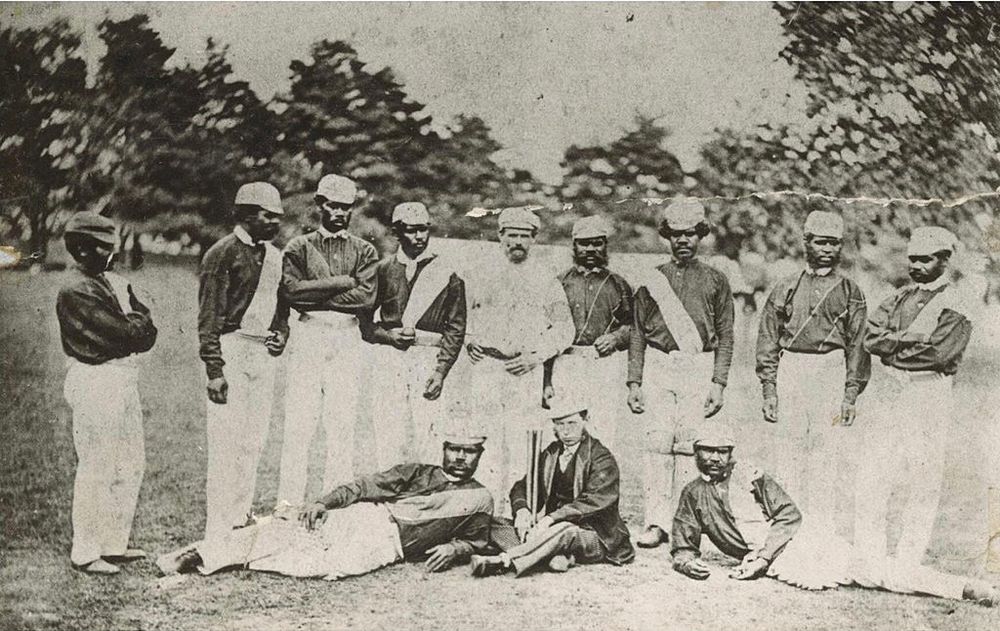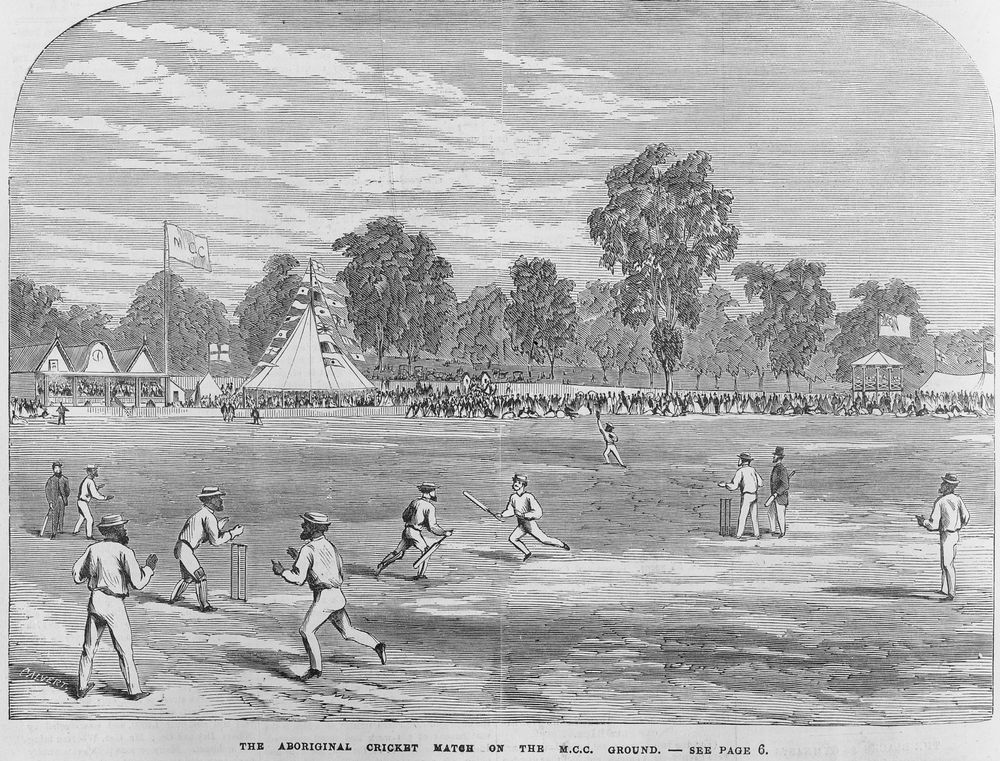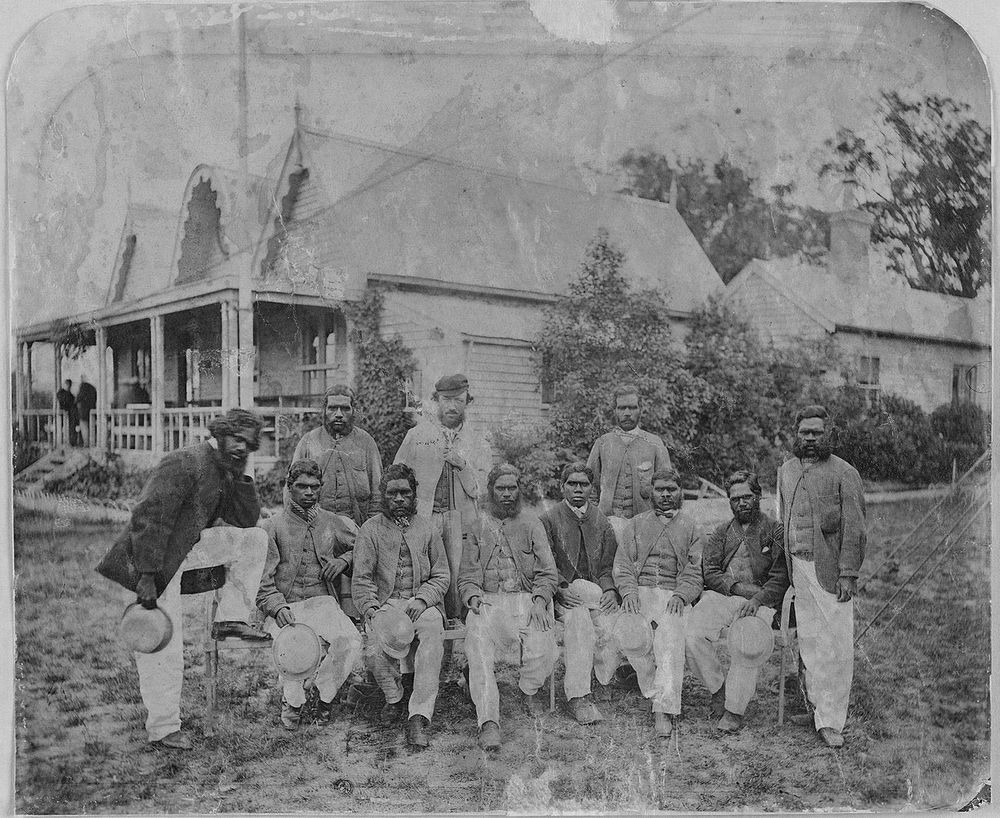Sports has been an important way to bridge different cultures. For the aboriginal Australians and their colonial settlers, it was cricket.
Cricket was first played in Australia in the early 1800s in Sydney in an area now part of Hyde Park. The game came to Melbourne around 1838 with the formation of the Melbourne Cricket Club. Cricket was introduced to the aboriginals in South Australia in the 1850s as a method of controlling the native population, to stop boredom and prevent them from straying back into the bush. Cricket matches regularly took place on cattle stations where aboriginals were employed as stockmen. Cricket was also used as a way of “civilising” the aboriginal people and introducing them to white values.

The first Australian cricket team touring England.
Thomas Gibson Hamilton, a ranch owner in the Western District of Victoria, took admiration of the athletic skills of the aboriginals, and created a team consisting of the best aboriginal players. They played an exhibition match at Hamilton, which gained the attention of Australia’s most celebrated sportsman, Tom Wills, captain of the Victoria cricket team.
In 1866, plans were made by the Melbourne Cricket Club to host and play against an aboriginal team from Victoria's Western District, and Wills agreed to coach the aboriginal players. In just four months, he managed to build a team strong enough—according to him—to face the Melbourne Cricket Club. The MCC became so nervous of Wills’ claims that they tried to strengthen their ranks by enlisting players who were not members of the MCC, attracting widespread criticism in the process.
On Boxing day 1866, a crowd of over 10,000 spectators turned up at the Melbourne Cricket Ground.

The magazine Bell's Life in Victoria reported: “Seldom has a match created more excitement in Melbourne than the one under notice, and never within our recollection has a match given rise to so much feeling on behalf of the spectators.”
“The veteran Wills never captained an eleven who so thoroughly possessed the sympathies of the spectators,” wrote a correspondent for The Sydney Mail.
Although the aboriginals lost against the MCC’s reinforced team, the aboriginal players won unanimous praise for their performance. The team subsequently toured Victoria where they showed marked improvement under Wills’ guidance.
In February 1867, Wills and his team went to Sydney to begin an intercolonial and overseas tour. However, after their arrival in Sydney, one of their promoters embezzled some of the funds raised to finance the enterprise, and left the team stranded, dashing any hopes of a trip overseas. The team was looked after by New South Wales captain Charles Lawrence, who also organized a number of games for the team to play in New South Wales. By the end of the New South Wales leg of the tour, Lawrence had replaced Wills as captain, who turned his attention to football.

The Aboriginal cricket team pictured with their captain and coach Tom Wills at the Melbourne Cricket Ground, December 1866.
With the help of new financial backers, Lawrence prepared a team for an overseas tour of England. The team left Sydney in February 1868, arriving in London in May. This was the first time an organized group of Australian sportspeople had travelled to England.
When the team first arrived in England, they were not taken too seriously. The Times described the visiting players as “a travestie upon cricketing at Lord's”, and, “the conquered natives of a convict colony.” The Daily Telegraph said of Australia that, “nothing of interest comes from there except gold nuggets and black cricketers.”
The first match was played at The Oval, London, on 25 May and it attracted 20,000 spectators. Many of these spectators attended out of curiosity, rather than to savor a cricket contest. After the publication of Charles Darwin's The Origin of Species in 1859, there was much fascination for “exotic races”. They were seen, not just as cricketers, but as a curious example of colonised indigenous people of the British empire who had been “civilised” by adopting the game of cricket. The Times reported:
Their hair and beards are long and wiry, their skins vary in shades of blackness, and most of them have broadly expanded nostrils. Having been brought up in the bush to agricultural pursuits under European settlers, they are perfectly civilized and are quite familiar with the English language.

The tour had a punishing schedule of 47 two-day matches in 40 towns and counties, against intermediate-level English amateur teams. The players were on the field a staggering 99 days out of 126 they were on tour.
The Australians surprised their competitors by winning 14, losing 14 and drawing 19 of their 47 matches. Some of the players showed great sporting prowess. Johnny Mullagh scored 1,698 runs, bowled 1877 overs (831 of which were maidens), and took and astonishing 245 wickets. He also achieved four stumpings while playing as wicketkeeper. An admired English fast bowler of the time, George Tarrant, bowled to Mullagh during a lunch interval and later said, “I have never bowled to a better batsman.”
Aside from playing cricket, the aboriginals were forced to perform a range of traditional sports and display skills such as boomerang and spear throwing. They also took part in bizarre contests such as running 100 yards backwards and one involving picking up stones placed a yard apart. One member of the team, Jungunjinanuke, also known as ‘Dick a Dick’, used a club and shield to deflect and dodge cricket balls hurled at him by volunteers.

Johnny ‘Unaarrimin’ Mullagh.
The tour was struck by one serious tragedy. King Cole, arguably the side's most proficient fielder, took ill with a chest complaint after one match. His condition quickly worsened and he died. He was suspected to have been suffering from tuberculosis and pneumonia. Two other members of the team, Jim Crow and Sundown, heartbroken after King Cole's death, returned to Sydney in September, a month before the tour ended.
Financially, the tour was a success, officially netting a total profit of £2,176. The players were promised a salary of £50 each, which were to be paid when they returned home. Although the team members received accommodation and travel expenses, none of the aboriginal players received payments.
After the tour ended, most of the players returned to their former role as station hands, with the exception of Mullagh, who continued to play cricket for the Melbourne Cricket Club for some time.
In 1869, the Central Board for Aborigines introduced the Aboriginal Protection Act which prevented anyone from removing aboriginal person from the colony of Victoria without the approval of the government minister. This made it difficult for indigenous cricket players to continue playing competitive cricket.
It would be another hundred years, in 1988, before the next aboriginal side would visit England as part of Australia's bicentennial celebrations. In 1996, Jason Gillespie became the first aboriginal player to represent Australia in Test cricket.
References:
# Aboriginal cricket team, National Museum Australia
# Aboriginal cricket: The first Australian tour of England, 1868, BBC
# First Aboriginal cricket team arrives in England, Deadly Story












Comments
Post a Comment